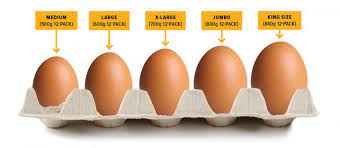Grading of Eggs
Grading of eggs is the sorting of eggs into different categories on the basis of some parameters like weight and internal quality in poultry. It helps in promoting identical packing and pricing and quality assurance to the consumers.
Importance Of Egg Grading
It stimulates the production of quality eggs and helps in reducing wastage. Straightforward market price reporting and easier advertising and establishment of brand names of the quality product are some of the other advantages of grading.
Types of Egg Grading
Basically, there is two way we can grade of eggs which is called BIS/ Agmark standard at the home. These are-
- Grade of table eggs based on egg weight
- Grade of table egg based on egg quality
But, it depends from country to country. Nevertheless, the requirement of egg grading more less the same worldwide. Therefore, I am going to elucidate the Indian which is called BIS/ Agmark standard.
- Grade of table eggs based on egg weight
Table eggs are defined as an egg that is normally used as a consumer product in the household in our daily life. the more common table eggs items are egg fry, egg omelet, used in cake, bread, ice-cream, and other recipes.
| Grade | Weight Per Egg (gram) | Weight per dozen eggs (gram) |
| Extra Large | 60 and above | 715 and above |
| Large | 53 to 59 | 631 to 714 |
| Medium | 45 to 52 | 535 to 630 |
| Small | 38 to 44 | 456 to 634 |
- Grade of table egg based on egg quality
Egg quality vitally depends on some common content of the egg. For instance, eggshell, egg white which is called albumin, Aircell and yolk. Summarise overall prerequisite below
| Quality Factors |
Grade-A | Grade-B |
| Shell | Unbroken. clean, sound, and normal shapes | Clean to moderately stained, sound but slightly abnormal |
| Airshell | 4 mm or less in-depth. practically regular | 8 mm or less in-depth, maybe free and slightly bubbly |
| Egg white | Clean and reasonably firm | Clear and slightly weak |
| Yolk | Fairly centered, practically free from defects, outline indistinct | It May be slightly off-centered, outline slightly visible |
grading of eggs also depends on egg-containing feces in some instances. Some Emeria spp is responsible for causing intestinal coccidiosis to cause indigestion and leading low-grade eggs.
How to perform Egg grading manually?
- The weight of the egg is to be taken with the help of egg’s weighing balance.
- The eggshellis to be inspected visually for its cleanliness and the egg is to be candIed for judging the soundness of the eggshell.
- By means of handling the egg, the shape of the air cell can be known. The depth of air cells can be measured with the help of a measuring scale.
- The firmness of egg white and the position ofyolk can be judged with the help of the candling of the shelled egg.
GRADING OF EGG BY USDA
According to the USDA, grading generally involves the sorting of products according to
- quality
- size
- weight,
- and other factors that determine the relative value of the product.
United States Weight Classes for Consumer Grades of Shell Eggs
| SIZE OR WEIGHT CLASS | MINIMUM NET WEIGHT PER DOZON (OZ) |
MINIMUM NET WEIGHT PER DOZON (LB) |
MINIMUM WEIGHT FOR INDIVIDUAL EGGS AT RATE PER (OZ) |
| Jumbo | 30 | 56 | 29 |
| Extra large | 27 | 50.5 | 26 |
| Large | 24 | 45 | 23 |
| Medium | 21 | 39.5 | 20 |
| Small | 18 | 34 | 17 |
| Peewee | 15 | 28 | – |
USDA EGG GRADING
United States grades for individual shell eggs are
- AA
- A
- B
Summary of United States Standards for Quality of Individual Shell Eggs
| Quality factor | AA quality | AA quality | A quality |
| Shell | Clean unbroken practically normal |
Clean unbroken practically normal |
Clean to slightly stained a Unbroken Abnormal |
| Air cell | 1/2 in. or less in depth Unlimited movement and free or bubbly |
3/16 in. or less in depth Unlimited movement and free or bubbly |
Over 3/16 in. in depth Unlimited movement and free or bubbly |
| White | Clear Firm |
Clear Reasonably firm |
Weak and watery Small blood and meat spots present b |
| Yolk | Outline-slightly defined Practically free from defects |
Outline-fairly well defined Practically free from defects |
Outline-plainly visible Enlarged and flattened Clearly visible germ development but no blood Other serious defects |
Source: USDA (1983A).
| Dirty c | Check c |
| Unbroken; adhering to dirt or foreign material, prominent stains, moderate stained areas in excess of B quality |
Broken or cracked shell but membranes intact, not leaking d |
Source: USDA (1983A).
Note
a=Moderately stained areas permitted (~ of the surface if localized, or 1’6 if scattered). b=If they are small (aggregating not more than 1 in. in diameter). c=For eggs with dirty or broken shells, the standards of quality provide two additional qualities. d=Leaker has broken or cracked shell and membranes, and contents leaking or free to leak.
How to grade chicken eggs?
There are various way to grading chicken eggs. Basically, there are two world-class method for the grading of chicken egg perfectly-
- Agmark grading of eggs
- USDA method of egg grading
TABLE EGGS GRADING AND MARKING RULES
COLD STORAGE OF SHELL EGGS – CODE OF PRACTICE
Grading-of-eggs
TABLE EGGS GRADING AND MARKING RULES
COLD STORAGE OF SHELL EGGS – CODE OF PRACTICE




